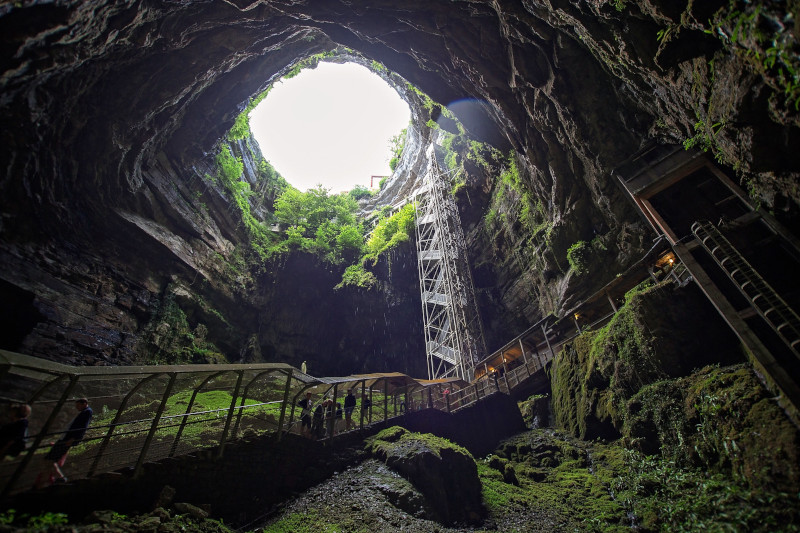Padirac Cave Facts
- The english name for this breathtaking work of Nature is that of Padirac Cave. In the language of its region, however, it’s called gouffre de Padirac. In any human language, though, it remains a marvel of geology little-known outside of its immediate region.
- It’s presently unkown if prehistoric man knew of the marvel of natural proceses. The first known mentioning of the incredible site, however, occurred in the 3rd century. The first known habitation of the cave by humans took place during the 15th century.
- Likewise, the first recorded visitation of the location for the purpose of tourism took place on November 1, 1898. Following the success of that visit, the government of the country it lies in officially opened it for ongoing tourist visits on April 10, 1899.
- These actions began with the first known exploration of Padirac Cave in 1889, by Édouard-Alfred Martel, considered the father of modern speleology. Credit for opening it to the public, however, usually goes to Guy de Lavaur, who arrived there in 1938.
- The current method of access, visible here, came into existence in the 1930’s. Once in the marvelous cave, visitors can tour the site either on foot or by boat. For the moment, though, only about 5% of the many amazing galleries present are open to the public.
- Presently, this marvelous site represents the most frequently visited underground site in the country in which it formed. An average of 350,000 people visit it each year. The highest recorded yearly count, however, reached 460,000 in the year 1991.
Related Articles
Padirac Cave Physical Description
Though the wondrous Padirac Cave hasn’t garnered worldwide fame, that’s no reflection on the natural wonders to be found within its confines. That’s because, fame or no, it holds some of the most spectacular sights to be found in any such location on earth.
Those sights also take several different forms, as one quickly learns when visiting the site. Those discoveries begin with the opening one uses to access the cave. A highly circular opening in the surface of the earth exposes a truly visually impressive chasm.
This feature of the site further measures a respectable 338 ft (103m ) deep. Its diameter, meanwhile, measures an equally impressive 108 ft (33 m). The large circular opening further amazes visitors due to what greets them on its mainly limestone walls.
That’s because a verdant green mixture of plants and moss also line the sides of that chasm. At the bottom of that opening, visitors access several chambers, each with wonders of is own. These further lead to other chambers, many of which still remain unexplored.
A small underwater river still remains in Padirac Cave, allowing the boat access. A stunning collection of stalagmites and stalactites also staggers the mind, especially with their brilliant hues. Other forms of speleothems further appear throughout the beautiful cave.
Padirac Cave Location, Formation, and Geology
The visually stunning Padirac Cave formed in region of the globe already renowned for possessing many locations of great natural splendor. That’s due to the fact that this marvelous example of the works of geological processes formed on the continent of Europe.
More precisely, the site sits in what now constitutes the country of France, in the roughly southwestern portion of the continent. In France itself, the cave lies in the Lot department, in the Occitanie region. That puts it in the deep southern part of the country.
The formation of this marvel began with the depositing of the mineral limestone in the region. This action occurred during the Jurassic Period, around 170 million years ago. Tropical lagoons covered the area at that time, thereby depositing marine sediments.
That eventually turned into the limestone of the region. As water subsequently began flowing through this area, it began the carving out of the gorgeous chambers. Evidence further indicates that this process began somewhere between 1 – 2 million years ago.
The timeline for the breathtaking opening into Padirac Cave, however, remains a matter of debate. The leading theory, however, indicates that natural processes slowly dissolved the limestone of the roof. As the cave expanded, the roof eventually collapsed.
Among the many awe-inspiring features of the cave is a massive stalactite, named the Great Pendant. Its tip very nearly touches the flowing water. Perhaps the most impressive feature of the system, however, is a relatively massive cavern, named the Grand Dome.
Features Sharing Its Region
Check out our other articles on 3 Tantalizing Tasmanian Animals, Chinese Giant Salamander, Lord Howe Island, Mandrinette, Green Milkweed Grasshopper, White-Nosed Coati

